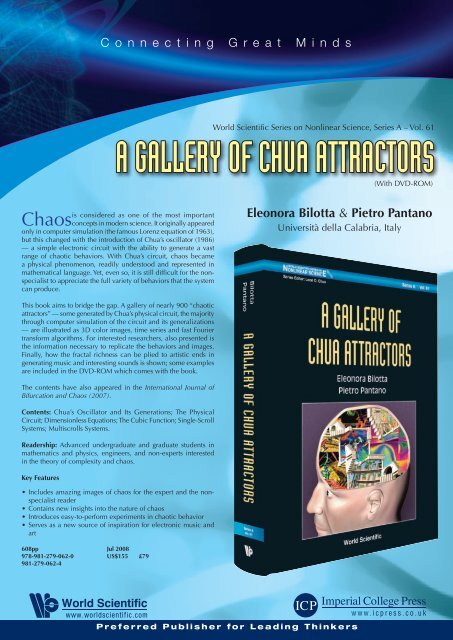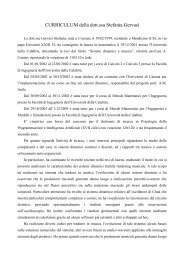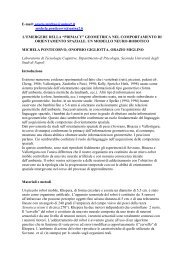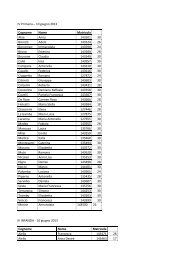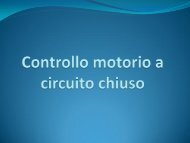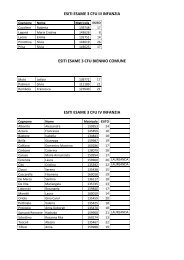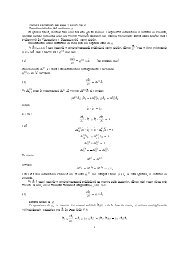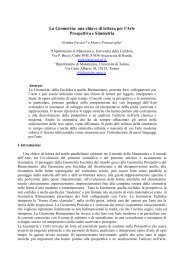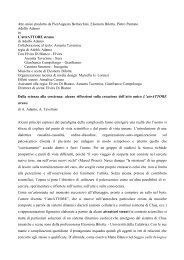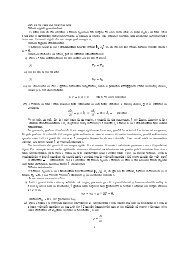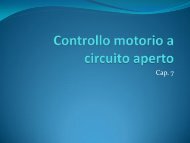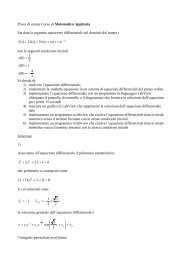A GALLERY OF CHUA ATTRACTORS - Università della Calabria
A GALLERY OF CHUA ATTRACTORS - Università della Calabria
A GALLERY OF CHUA ATTRACTORS - Università della Calabria
Create successful ePaper yourself
Turn your PDF publications into a flip-book with our unique Google optimized e-Paper software.
Connecting Great Minds<br />
World Scientific Series on Nonlinear Science, Series A – Vol. 61<br />
A <strong>GALLERY</strong> <strong>OF</strong> <strong>CHUA</strong> <strong>ATTRACTORS</strong><br />
(With DVD-ROM)<br />
is considered as one of the most important<br />
Chaos concepts in modern science. It originally appeared<br />
only in computer simulation (the famous Lorenz equation of 1963),<br />
but this changed with the introduction of Chua’s oscillator (1986)<br />
— a simple electronic circuit with the ability to generate a vast<br />
range of chaotic behaviors. With Chua’s circuit, chaos became<br />
a physical phenomenon, readily understood and represented in<br />
mathematical language. Yet, even so, it is still difficult for the nonspecialist<br />
to appreciate the full variety of behaviors that the system<br />
can produce.<br />
Eleonora Bilotta & Pietro Pantano<br />
Università <strong>della</strong> <strong>Calabria</strong>, Italy<br />
This book aims to bridge the gap. A gallery of nearly 900 “chaotic<br />
attractors” — some generated by Chua’s physical circuit, the majority<br />
through computer simulation of the circuit and its generalizations<br />
— are illustrated as 3D color images, time series and fast Fourier<br />
transform algorithms. For interested researchers, also presented is<br />
the information necessary to replicate the behaviors and images.<br />
Finally, how the fractal richness can be plied to artistic ends in<br />
generating music and interesting sounds is shown; some examples<br />
are included in the DVD-ROM which comes with the book.<br />
The contents have also appeared in the International Journal of<br />
Bifurcation and Chaos (2007).<br />
Contents: Chua’s Oscillator and Its Generations; The Physical<br />
Circuit; Dimensionless Equations; The Cubic Function; Single-Scroll<br />
Systems; Multiscrolls Systems.<br />
Readership: Advanced undergraduate and graduate students in<br />
mathematics and physics, engineers, and non-experts interested<br />
in the theory of complexity and chaos.<br />
Key Features<br />
• Includes amazing images of chaos for the expert and the nonspecialist<br />
reader<br />
• Contains new insights into the nature of chaos<br />
• Introduces easy-to-perform experiments in chaotic behavior<br />
• Serves as a new source of inspiration for electronic music and<br />
art<br />
608pp Jul 2008<br />
978-981-279-062-0 US$155 £79<br />
981-279-062-4<br />
Preferred Publisher for Leading Thinkers
CONTENTS of A Gallery of Chua Attractors<br />
Nonlinear Book Series A Vol.61<br />
Chapter 1. Chua’s Oscillator and Its<br />
Generalizations<br />
1. Introduction<br />
2. Chua Oscillator<br />
3. Diode with Cubic Function<br />
4. n-Scroll Attractors<br />
5. From Chaos to Hyperchaos<br />
6. A Gallery of Chua Attractors<br />
7. Conclusions<br />
Chapter 2. The Physical Circuit<br />
1. Introduction<br />
2. A Gallery of Attractors<br />
3. Visualization Issues<br />
4. Conclusions<br />
Chapter 3. Dimensionless Equations<br />
1. Introduction<br />
2. Information Seeking in Chaos Domain<br />
3. The Main Features of the Gallery<br />
4. Representing Parameter Space<br />
5. Conclusions<br />
Chapter 4. The Cubic Equation<br />
1. Introduction<br />
2. A Gallery of Attractors<br />
3. Representations of Parameter Space<br />
4. Laws of Morphogenesis<br />
5. Shape Distance in Phase Space<br />
6. Conclusions<br />
Chapter 5. Single-Scroll Systems<br />
1. Introduction<br />
2. The Gallery of Attractors<br />
3. Representing Attractors in Parameter Space<br />
4. Visualizing the Parameter Space: The Inertial Ellipsoid Method<br />
5. Visualizing Parameter Space: The Hausdorff Distance Method<br />
6. Conclusions<br />
Chapter 6. Multiscrolls Systems<br />
1. Introduction<br />
2. Formal Aspects of n-Scroll, Hyper-chaotic and Synchronized<br />
Systems<br />
3. The Gallery<br />
4. Computational Tools<br />
5Th 5. The<br />
Virtual Museum and the Navigable Galleries<br />
6. Conclusions
CD Contents<br />
Together with the book, readers will find an audio CD with thirteen pieces, obtained by<br />
editing the original music generated by Chua’s circuit. In what follows, we provide additional<br />
details on the edited pieces.<br />
Track 1<br />
This piece was produced from a selection<br />
of tunes produced by the Chua attractor.<br />
Track 2<br />
Here a single time series is subjected to<br />
a sequence of transformations, each of<br />
which doubles the previous tempo.<br />
Track 3<br />
This piece explores the possibility of<br />
creating traditional musical forms, using<br />
material produced by the Chua attractor.<br />
Track 4<br />
This piece is based on two different time<br />
series representing similar melodies<br />
which have both been produced in the<br />
same way.<br />
Track 5<br />
Here, the three coordinates of the Chua<br />
attractor are used to code the pitch,<br />
volume and duration of the notes.<br />
Track 6<br />
This piece attempts to recreate classical<br />
feelings of “lightness”. A single time<br />
series is subjected to various time<br />
transformations, with each version being<br />
played on a different instrument.<br />
Track 7<br />
The raw material for this piece was<br />
produced by filtering the data from the<br />
attractor to produce scales in different<br />
keys.<br />
Track 8<br />
Different parts were obtained by<br />
transforming note durations in a single<br />
original time series.<br />
Track 9<br />
In this piece, the aim was to create musical<br />
structures similar to those we find in<br />
serious music from the beginning of the<br />
XX century.<br />
Track 10<br />
This piece uses three distinct time series to<br />
create a complex orchestrated structure.<br />
Whenever the values lie within a specific<br />
range they are assigned to specific<br />
instruments.<br />
Track 11<br />
This piece presents the chaotic<br />
expressiveness of a Chua attractor, without<br />
any arrangement required by the user. The<br />
three time-series of the system play three<br />
different musical instruments.<br />
Track 12<br />
This fragment shows the expressive<br />
capabilities of the circuit without any<br />
external arrangement. Sample times are<br />
very narrow, causing a perceptive cohesion<br />
and the creation of new timbres.<br />
Track 13<br />
This is a collection of many pieces<br />
obtained from different Chua attractors<br />
and using different codification processes.<br />
In each composition, the three time-series<br />
of the system play three different musical<br />
instruments.
ORDER FORM<br />
Please complete the form and send it to any of our offi ces below.<br />
Alternatively, you can order via our online bookshop at www.worldscientific.com<br />
• NORTH & SOUTH<br />
AMERICA<br />
• EUROPE & THE<br />
MIDDLE EAST<br />
• ASIA & THE<br />
REST <strong>OF</strong> THE<br />
WORLD<br />
World Scientific Publishing Co. Inc.<br />
27 Warren Street, Suite 401-402, Hackensack, NJ 07601, USA Toll-free fax: 1 888 977 2665 Toll-free: 1 800 227 7562 Email: sales@wspc.com<br />
World Scientific Publishing (UK) Ltd.<br />
c/o Marston Book Services, P O Box 269, Abingdon, Oxon OX14 4YN, UK Fax: 44 (0) 123 546 5555 Tel: 44 (0) 123 546 5500 Email: direct.orders@marston.co.uk<br />
World Scientific Publishing Co. Pte. Ltd.<br />
Farrer Road, P O Box 128, SINGAPORE 912805 Fax: 65 6467 7667 Tel: 65 6466 5775 Email: sales@wspc.com.sg<br />
TITLE SELECTION<br />
TITLE(S) ISBN QTY<br />
PRICE (US$/£)<br />
A <strong>GALLERY</strong> <strong>OF</strong> <strong>CHUA</strong> <strong>ATTRACTORS</strong><br />
978-981-279-062-0<br />
981-279-062-4<br />
MODE <strong>OF</strong> DELIVERY<br />
Please select your preferred mode of delivery. For delivery charges, please contact any of our worldwide offi ces.<br />
USA Canada UK Europe Asia Mexico & Middle East &<br />
South America Others<br />
Air Mail N/A 1-2 weeks 1-2 weeks 1-3 weeks 1-2 weeks N/A 3-4 weeks<br />
Surface Mail N/A 2-3 weeks 1-2 weeks 3-6 weeks 4-8 weeks 4-6 weeks 8-10 weeks<br />
UPS 1-2 weeks N/A N/A N/A N/A N/A N/A<br />
METHOD <strong>OF</strong> PAYMENT<br />
Cheque/Bank draft enclosed for US$/£<br />
• For cheque payment in North and South America, please make cheque payable to “World Scientific Publishing Co. Inc.”<br />
• For cheque payment in Europe and the Middle East, please make cheque payable to “Marston Book Services”<br />
• For cheque payment from the rest of the world, please make cheque payable to “World Scientific Publishing Co. Pte. Ltd.”<br />
Charge my VISA MC Amex<br />
Card No:<br />
Exp. Date:<br />
Bill my company/institution:<br />
(please attach purchase order)<br />
Signature:<br />
Tel:<br />
• Special Prices are available to developing countries and some Eastern European countries. Please write in for further details.<br />
• Prices subject to change without prior notice.<br />
CONTACT INFORMATION<br />
Title & Name:<br />
Organization:<br />
Address:<br />
City/State/Zip:<br />
Country:<br />
Email:<br />
Please inform me by email on new publications by World Scientific and Imperial College Press.<br />
@<br />
Join our<br />
mailing list<br />
for our<br />
latest publications &<br />
offers<br />
Please visit<br />
www.worldscientific.com/mailinglist.html<br />
Fields of interest:<br />
Printed in Aug 2008 NEW JERSEY • LONDON • SINGAPORE • BEIJING • SHANGHAI • HONG KONG • TAIPEI • CHENNAI<br />
SP/JN/07/08/06/CC


